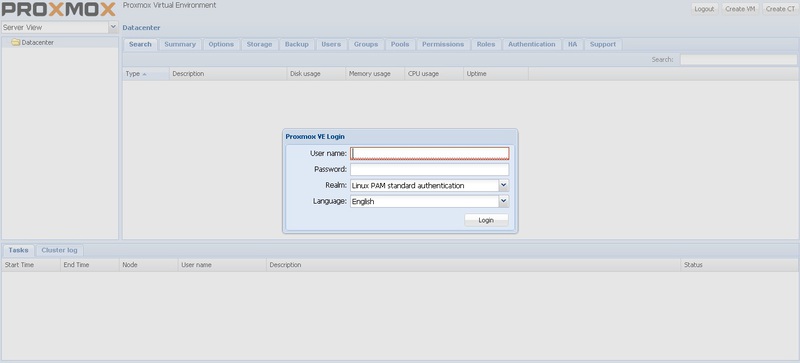Installing the virtualization management system (openvz, kvm) proxmox 2.2 on a server in Hetzner

Proxmox is an end-user web interface for managing virtual machines that allows you to create linux virtual machines in kvm and openvz containers, windows in kvm. Cut video resources to cpu cores, memory size, io limits in megabytes per second and iops (only kvm). There are automatic backups, it is possible to do them on a remote storage, you can mark some disks in virtual machines with a “not for backup” checkmark.
From the beginning, we order a server in hetzner with virtualization support in the processor (these are all ex and xs servers) with Debian 6.0 minimal x64bit. On weekdays, the server is usually given to me within an hour. Next, go over ssh and change the root password for greater security.
passwd root
Install proxmox
Install proxmox repository key
wget -O- “ download.proxmox.com/debian/key.asc ” | apt-key add - We write it in /etc/apt/sources.list
# PVE packages provided by proxmox.com
deb download.proxmox.com/debian squeeze pve
We update the data from the
apt-get update repository
Install proxmox
aptitude install proxmox-ve -2.6.32
reboot The
web interface is accessible via ip : 8006 is written in extjs and is pretty nice.
Ready-made images for openvz containers can be downloaded from download.openvz.org/template/precreated , put them in the folder
/ var / lib / vz / template / cache
Searches for installing operating systems for kvm should be put in / var / lib / vz / template / iso
Order additional ip and configure network
The next step is to order the IP address subnet in the control panel hetzner robot.your-server.de (single ip give out 1 euro up to three pieces) select the server there and go to the ips folder and click on Ordering of additional IP, failover IP or subnet, select the desired subnet size, in the graph as you will use them, I usually indicate for my new vps. The cost of a subnet for 8 ip 15 + 5.4 = 20.4 euros, for 16 ip 15 + 11.2 = 26.2 euros. Ip on a weekday during business hours issue within an hour.

After that, we need to configure the vmbr interface in proxmox, if you were given a subnet of 78.36.234.176 / 29 t in proxmox, select your server-> network> create-> bridge

After that, you need to reboot or in the linux console do service networking restart to start new interface.
Regarding ipv6 for kvm, I still couldn’t start it in three days of torment, if anyone has a working config for proxmox with ipv6 I will be glad to see it.
Well, in general, the system is ready to work, you just have to download iso or images for openvz and click the create ct (openvz) and create vm (kvm) buttons.
Problems
There are problems installing proxmox on the EX 6S server (problems with drivers on the network for the current kernel version, I had to manually install the older proxmox kernel, the problem was observed in proxmox 2.1, possibly resolved in 2.2) and EX 4S (the problem is in the current version time to time server hang, at the moment proxmox has been updated from version 2.1 to 2.2, it is possible that something has been fixed, the problem is observed on several servers).
If you have any questions, ask.
UPD1 from fon.vosi@gmail.com:
Hi, I'm a banned troll from the hub (http://habrahabr.ru/users/vosi/))))
I wanted to supplement the article with my experience in configuring ipv6
, it works for me
in / etc / network / if-up.d /
lies the ipv6 executable
in it
#! / bin / sh
ifconfig vmbr0 add 2a01: ----: 161: 90c0: 0100 :: 1/80
ip -6 route add 2a01: ----: 161: 90c0 :: 1 dev vmbr0
ip -6 route add default via 2a01: - ---: 161: 90c0 :: 1 dev vmbr0 by
this I assigned un 2a01: ----: 161: 90c0: 0100 :: 1 with a subnet of 80 in physical. the machine
further, in the container
/ etc / network / interfaces
auto eth0
iface eth0 inet static
address 5.5.5.5
netmask 255.255.255.224
gateway 5.5.5.1
iface eth0 inet6 static
address 2a01: ---: 161: 90c0: 101 :: 1/80
up ip -6 address add 2a01: ---: 161: 90c0: 101 :: 2 dev eth0
up ip -6 address add 2a01: ---: 161: 90c0: 101 :: 3 dev eth0
up ip -6 address add 2a01: ---: 161: 90c0: 101 :: 4 dev eth0
up ip -6 address add 2a01: ---: 161: 90c0: 101 :: 5 dev eth0
up ip -6 address add 2a01: ---: 161: 90c0: 101 :: 6 dev eth0
up ip -6 address add 2a01: ---: 161: 90c0: 101 :: 7 dev eth0
up ip -6 address add 2a01: ---: 161: 90c0: 101 :: 8 dev eth0
up ip -6 address add 2a01: ---: 161: 90c0: 101 :: 9 dev eth0
repeat for others, if necessary, like mine, each site has its own ip6
up ip -6 route add 2a01: ---: 161: 90c0 :: / 64 dev eth0
up ip -6 route add default via 2a01: ---: 161: 90c0 :: 1 dev eth0
that's all, the traffic inside your subnet is spinning inside, it goes through the Hetzner gate by the
way By the way, I’d add it to the lvm ... because by default the hetzner is kinda does not install sections of lvm, I rearranged debian manually
there is a nuance that needs to be left unallocated in a physical volume somewhere around 10-20 gig (well, depending on the size of the containers), so that online backups work (that is, without stopping the virtual container using a dump of the logical volume)
with every dump - a temporary logical volume is created, for this it is necessary to leave free space in the physical. volume
and yet, the logical volume for backups must be separate ... because no way to dump the current logical volume to the current
